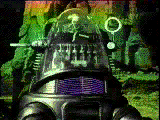
Altough screwdriver-programmed (FORTRAN, the first programming language, only came one decade later) and used mainly for math calculations, the idea of a machine that could mime human thought impressed the common sense very strongly, so much that a common myth about computers is that they are something close to an oraculus : can answer any question about any subject flawlessly and faster than a human could.
In spite of that myth, the 40's computers were far from being practical ou movable. Mark I, one of ENIAC's ancestors, needed 120 cubic meters! ENIAC required a customized cooling system to refresh its 18000 valves.
One could expect that the anxiety about computers became something with dramatic possibilities in hollywood. As you cannot make 120 cubic meters as agile and seductive as a movie hero, there was found a very smart solution to this problem : put the computer into some human form and justify it as passed in the future, when that should be possible. Paint it with pseudo-science and voilà! There come endless sci-fi flicks!

The idea of robots came before the computers itself, as quoted in 2.The Helpers. Between the two world wars, specifically in the "crazy twenties", the fad that swept Europe was the "futurism". Adoration for machines, speed and authomaticism reflected the simpathy for the fascism that , sadly, came true.
In a world like this, the idea of helpers subservient performing repetitive tasks had everything necessary to be believed, as it was. The word "robot" appeared first, already meaning this, in a book by Karel Capek, tchekoslovakian sci-fi author of the 20's. In Fritz Lang's "Metropolis", the most enduring image of the movie is the android, generated from the plot's naïve (?!!?). As there was no such thing as a computer in the pre-war years, they do not take part in these creations.
Let's go back to the post-war years. The growing curiosity on making the machines protagonists brought the robots to hollywood. They could interact with human characters and also outdo them in many subjects. There began the confusion between what machines can actually do and what the scriptwriters think they can.
In these clips, Robby the Robot from Forbidden Planet, carries 10 tons of lead with no particular effort.On the right one, he also works prét-a-porter , making a new dress for Altaira, the daughter of the planet's owner.
No doubt about it: a computer can surely do math better than a human, but when a robot-character carries 10 tons of lead, generates eyeproof dresses and duplicates 90 gallons of whisky that by no means is the task of a machine, but of a "lamp genie"!!
Other very common feature of computer characters in the movies is its arrogance with humans. For the best and for the worst, it is the consciousness of each own's limitations and flaws that makes humbleness grow in men and women. When one's three year old, there is no trace of humbleness. We all feel as if we were the lords of the world (that's when, also, when the hard way towards finding one's place begins). Hey, if you give a robot the capacity to overcome human limitations AND put a human to describe how shoud it look like, there's a good chance the characterization will be arrogant and selfish, because it mirrors oneself, without any self-imposed barriers.
Never mind how much sci-fi-esque a movie wants to be, it will meet the trashcan of history if the audience doesn't get what's the point. So it is fundamental that details familiar to the audience are inserted among the plot. One point sows very efficently the state-of-the-art of the tecnology of Forbidden Planet's time. Altough Robby the Robot thinks he is the king of the hill, he thinks with switches before answering.


 Roberto Tietzmann - RTIETZ@CESUP.UFRGS.BR
Roberto Tietzmann - RTIETZ@CESUP.UFRGS.BR
 Welcome page |
LEAD Home
Welcome page |
LEAD Home